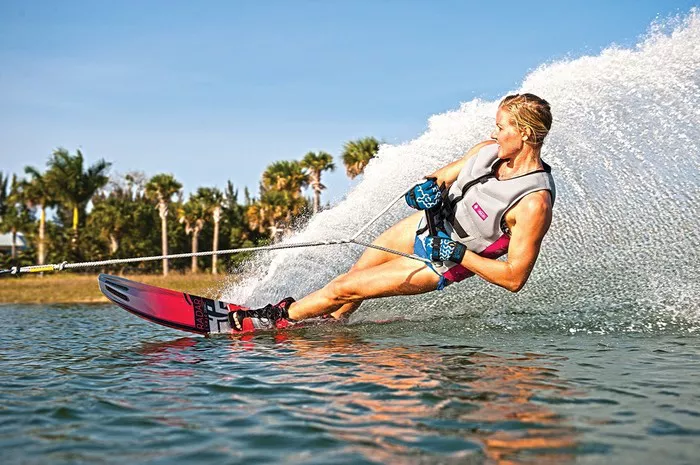Water skiing is a thrilling water sport enjoyed by individuals of all ages around the world. It combines elements of balance, coordination, and adrenaline-pumping excitement, making it a popular choice for those seeking adventure on the water. Whether you’re a beginner looking to try your hand at this exhilarating activity or a seasoned enthusiast aiming to enhance your skills, having the right equipment is essential for a safe and enjoyable experience.
In this comprehensive guide, we’ll delve into the essential gear needed for water skiing, covering everything from skis and bindings to safety equipment and accessories. By understanding the components that make up a complete water skiing setup, you’ll be better equipped to hit the waves with confidence and competence.
1. Water Skis
At the heart of any water skiing setup are the skis themselves. These specialized boards come in various shapes, sizes, and designs, each catering to different skill levels and preferences. Beginners typically start with wider, more stable skis, while advanced skiers may opt for narrower, high-performance models.
2. Bindings
Bindings are the interface between the skier and the skis, securing the feet in place while allowing for flexibility and control. Like skis, bindings come in different styles to accommodate various foot sizes and riding preferences. It’s crucial to ensure that bindings fit comfortably and securely to prevent injury and optimize performance.
3. Tow Rope
A reliable tow rope is essential for water skiing, providing the connection between the boat and the skier. Opt for a durable rope specifically designed for water sports, with sufficient length to accommodate different skill levels and towing preferences. Look for ropes with comfortable handles and a reliable grip to minimize hand fatigue and ensure a secure hold.
4. Life Jacket
Safety should always be a top priority when participating in water sports, and a properly fitting life jacket is a must-have piece of equipment for water skiing. Choose a Coast Guard-approved flotation device designed for water skiing or wakeboarding, ensuring it fits snugly and provides adequate buoyancy in the water. Additionally, consider features such as impact protection and reflective detailing for added safety during low-light conditions.
5. Wetsuit or Rash Guard
Depending on the water temperature and personal preference, wearing a wetsuit or rash guard can help keep you comfortable and protected while skiing. These garments provide insulation against cold water, reduce chafing, and offer added UV protection from the sun’s rays. Select a wetsuit or rash guard made from high-quality materials that allow for freedom of movement and quick drying to enhance your overall experience on the water.
6. Helmet
While not always a mandatory requirement, wearing a helmet can provide an extra layer of protection against head injuries while water skiing, especially at high speeds or in crowded waterways. Look for a helmet specifically designed for water sports, featuring impact-resistant materials and a secure fit system to ensure maximum safety and comfort.
7. Gloves
Gloves are optional but can offer several benefits for water skiers, including improved grip on the tow rope, reduced hand fatigue, and added protection against blisters and abrasions. Choose gloves made from quick-drying materials with reinforced palms for enhanced durability and grip, ensuring they fit snugly without restricting movement.
8. Sun Protection
Spending extended periods on the water exposes you to the sun’s harmful UV rays, making sun protection essential for preventing sunburn and long-term skin damage. Wear sunscreen with a high SPF rating, protective clothing such as hats and sunglasses, and seek shade whenever possible to minimize sun exposure while skiing.
9. Water Ski Bag
A water ski bag provides a convenient and protective way to transport and store your skis when not in use. Look for a durable, padded bag with ample storage space to accommodate your skis, bindings, and accessories, and consider additional features such as wheels or shoulder straps for added convenience when traveling to and from the water.
10. Maintenance and Care Supplies
Proper maintenance and care are crucial for prolonging the life of your water skiing equipment and ensuring optimal performance on the water. Stock up on essential supplies such as lubricants for bindings, wetsuit shampoo, and UV protectant for ski bindings and other gear exposed to the sun. Regularly inspect your equipment for signs of wear and tear, and address any issues promptly to prevent accidents or damage during use.
Conclusion
In conclusion, water skiing is an exhilarating and rewarding activity that offers fun and excitement for enthusiasts of all skill levels. By investing in the right equipment and safety gear, you can enjoy this thrilling sport while minimizing the risk of injury and maximizing your performance on the water. Whether you’re a novice or an experienced skier, prioritize safety, proper technique, and responsible behavior to make the most of your water skiing adventures.

